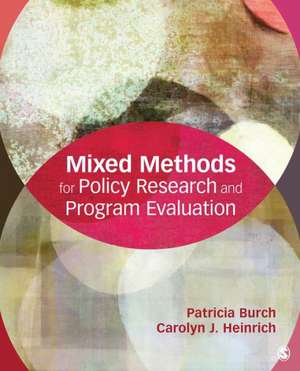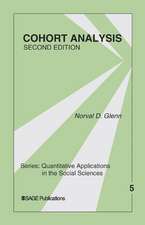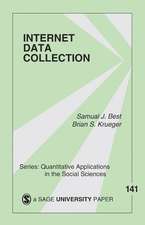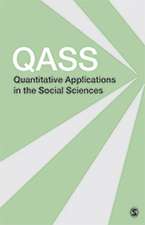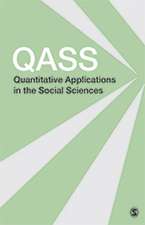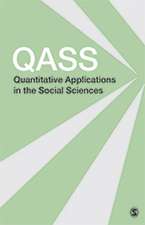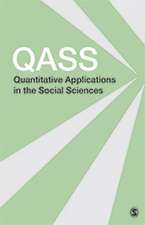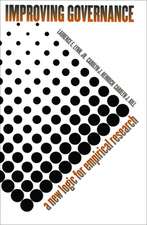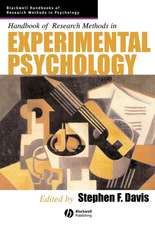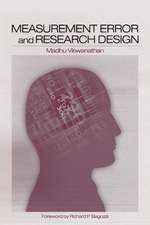Mixed Methods for Policy Research and Program Evaluation
Autor Patricia E. Burch, Carolyn J. Heinrichen Limba Engleză Paperback – 29 apr 2015
Preț: 517.31 lei
Preț vechi: 699.08 lei
-26% Nou
Puncte Express: 776
Preț estimativ în valută:
98.98€ • 103.63$ • 81.91£
98.98€ • 103.63$ • 81.91£
Carte disponibilă
Livrare economică 15-29 martie
Livrare express 01-07 martie pentru 27.15 lei
Preluare comenzi: 021 569.72.76
Specificații
ISBN-13: 9781452276625
ISBN-10: 1452276625
Pagini: 232
Dimensiuni: 187 x 232 x 18 mm
Greutate: 0.41 kg
Ediția:1
Editura: SAGE Publications
Colecția Sage Publications, Inc
Locul publicării:Thousand Oaks, United States
ISBN-10: 1452276625
Pagini: 232
Dimensiuni: 187 x 232 x 18 mm
Greutate: 0.41 kg
Ediția:1
Editura: SAGE Publications
Colecția Sage Publications, Inc
Locul publicării:Thousand Oaks, United States
Recenzii
Drawing on their extensive experience in large scale project management, Patricia Burch and Carolyn Heinrich clearly articulate an agenda for program and policy evaluation that is designed to ensure actionable evidence of the effectiveness of a program and its implementation is generated for all stakeholders. The examples they provide, while not minimizing the challenges of employing a mixed methods approach, will convince readers of the practicality and value of iteratively integrating both qualitative and quantitative approaches throughout the entire evaluation process, from initial design through data integration and analysis to dissemination of research findings. We can all learn from their experiences, so generously shared.
In a time of scarce resources for social programs, wise policy requires making tough choices. To do this well, policymakers need reliable information on what works, why some approaches are more successful than others, and what can be done to improve effectiveness. This book is a vital primer on how to do that. It attacks the mistaken view that quantitative and qualitative research are alternatives, rather than essential complements that, when combined in a mix of research methods, can best provide guidance to policymakers and practitioners.
This book is just what is needed as we move into a new phase of evidence informed policy and practice. It advocates an integrated and coherent approach to policy research and program evaluation while recognizing the realities and complexities of both policy and research. It will be immensely helpful to those engaged in mixed methods research across a variety of policy fields.
The gulf between qualitative and quantitative researchers is an old problem. With this useful and important new book, Burch and Heinrich help to bridge the divide, highlighting the need for a more complementary and integrated approach that can help us learn not just whether programs "work", but how and why they do.
This rich and sophisticated book provides a wealth of insights and practical guidelines that will enhance the work of both novice and experienced researchers. Burch and Heinrich show the way to making mixed methods research more relevant and more rigorous.
This is a very useful book for researchers and evaluators contemplating or already using mixed methods in policy research and evaluation, as well as for those teaching applied evaluation courses.
In this book, Burch and Heinrich have successfully explained how a mixed methods approach can be applied to policy analysis and evaluation. I highly recommend it for scholars applying mixed methods to the study of public policy issues. This book should be required reading for all public policy students and researchers.
The book’s biggest strength is its emphasis on the practicalities of integrating different methods throughout the life cycle of a research project. For example, all the chapters end with discussion questions, which force the reader to think through and better understand how the material presented might apply to their own work. The book is also illustrated with rich case studies (mostly from the education and social welfare arenas) to aid understanding.
In a time of scarce resources for social programs, wise policy requires making tough choices. To do this well, policymakers need reliable information on what works, why some approaches are more successful than others, and what can be done to improve effectiveness. This book is a vital primer on how to do that. It attacks the mistaken view that quantitative and qualitative research are alternatives, rather than essential complements that, when combined in a mix of research methods, can best provide guidance to policymakers and practitioners.
This book is just what is needed as we move into a new phase of evidence informed policy and practice. It advocates an integrated and coherent approach to policy research and program evaluation while recognizing the realities and complexities of both policy and research. It will be immensely helpful to those engaged in mixed methods research across a variety of policy fields.
The gulf between qualitative and quantitative researchers is an old problem. With this useful and important new book, Burch and Heinrich help to bridge the divide, highlighting the need for a more complementary and integrated approach that can help us learn not just whether programs "work", but how and why they do.
This rich and sophisticated book provides a wealth of insights and practical guidelines that will enhance the work of both novice and experienced researchers. Burch and Heinrich show the way to making mixed methods research more relevant and more rigorous.
This is a very useful book for researchers and evaluators contemplating or already using mixed methods in policy research and evaluation, as well as for those teaching applied evaluation courses.
In this book, Burch and Heinrich have successfully explained how a mixed methods approach can be applied to policy analysis and evaluation. I highly recommend it for scholars applying mixed methods to the study of public policy issues. This book should be required reading for all public policy students and researchers.
The book’s biggest strength is its emphasis on the practicalities of integrating different methods throughout the life cycle of a research project. For example, all the chapters end with discussion questions, which force the reader to think through and better understand how the material presented might apply to their own work. The book is also illustrated with rich case studies (mostly from the education and social welfare arenas) to aid understanding.
Cuprins
Chapter 1: Introduction: The Demand for and Value of Fully Integrated Qualitative and Quantitative Research
The Role of Mixed Methods Research in Meeting the Demand for Evidenced-Based Policy and Practice
What Distinguishes This Book in the Mixed Methods Literature
Overview of Remaining Chapters
Recommendations for How to Use This Book
Chapter 2: Conceptualizing Mixed Methods Research
Introduction
Rationale and Conditions for Mixed Methods Research
Categorizing Mixed Methods Approaches
Overview of a Fully Integrated, Mixed Methods Research Effort
Discussion Questions
Applications to Your Own Work
Chapter 3: Designing and Implementing Fully Integrated Mixed Methods Research
Introduction
Integration in Research Objectives and Design
Integration in Instrumentation Design and Data Collection
Integration in Data Analysis and Interpretation of Findings
Integration in Dissemination of Research Findings
Discussion Questions
Applications to Your Own Work
Chapter 4: Practical Tools for Integrated Mixed Methods Studies of Policy Implementation
Introduction
Mixed Methods Integration Strategy #1: Bridging Research Instruments for Qualitative and Quantitative Integration
Mixed Methods Integration Strategy #2: Mixed Methods Coding and Analysis Memoing
Mixed Methods Integration Strategy #3: Adapted Monitoring Tool and Research Reviews
Mixed Methods Integration Strategy #4: Research-to-Practice Collaborative
Conclusion
Discussion Questions
Applications to Your Own Work
Chapter 5: Fully Integrated Mixed Methods Research in K-12 and Higher Education in the United States
Introduction
Program Evaluation of Student Achievement Guarantee in Education
Racial and Ethnic Inequity in Access and Successful Student Outcomes in Higher Education
Challenges and Strategies for Addressing Challenges
Discussion Questions
Applications to Your Own Work
Chapter 6: An Application of Fully Integrated Mixed Methods in Program Development and Evaluation
Introduction
Program and Evaluation Motivation
Pilot Program Development for Child Support Debt Reduction
Demonstration Program Rollout and Early Evaluation Focus
Impact Evaluation Findings and Their Interpretation and Use
Conclusion
Discussion Questions
Applications to Your Own Work
Chapter 7: Mixed Methods Research in an International Context
Introduction
Child Support Grant Impact Evaluation in South Africa
Qualitative-Quantitative Integration Process in the CSG Impact Evaluation
Benefits of a Tightly Integrated Qualitative-Quantitative Research Approach
Conclusion
Discussion Questions
Applications to Your Own Work
Chapter 8: On the Future of Fully Integrated Mixed Methods Research: Context and Common Lessons From the Cases for the Field
How Context Matters
Broader Lessons for the Field
Concluding Thoughts
The Role of Mixed Methods Research in Meeting the Demand for Evidenced-Based Policy and Practice
What Distinguishes This Book in the Mixed Methods Literature
Overview of Remaining Chapters
Recommendations for How to Use This Book
Chapter 2: Conceptualizing Mixed Methods Research
Introduction
Rationale and Conditions for Mixed Methods Research
Categorizing Mixed Methods Approaches
Overview of a Fully Integrated, Mixed Methods Research Effort
Discussion Questions
Applications to Your Own Work
Chapter 3: Designing and Implementing Fully Integrated Mixed Methods Research
Introduction
Integration in Research Objectives and Design
Integration in Instrumentation Design and Data Collection
Integration in Data Analysis and Interpretation of Findings
Integration in Dissemination of Research Findings
Discussion Questions
Applications to Your Own Work
Chapter 4: Practical Tools for Integrated Mixed Methods Studies of Policy Implementation
Introduction
Mixed Methods Integration Strategy #1: Bridging Research Instruments for Qualitative and Quantitative Integration
Mixed Methods Integration Strategy #2: Mixed Methods Coding and Analysis Memoing
Mixed Methods Integration Strategy #3: Adapted Monitoring Tool and Research Reviews
Mixed Methods Integration Strategy #4: Research-to-Practice Collaborative
Conclusion
Discussion Questions
Applications to Your Own Work
Chapter 5: Fully Integrated Mixed Methods Research in K-12 and Higher Education in the United States
Introduction
Program Evaluation of Student Achievement Guarantee in Education
Racial and Ethnic Inequity in Access and Successful Student Outcomes in Higher Education
Challenges and Strategies for Addressing Challenges
Discussion Questions
Applications to Your Own Work
Chapter 6: An Application of Fully Integrated Mixed Methods in Program Development and Evaluation
Introduction
Program and Evaluation Motivation
Pilot Program Development for Child Support Debt Reduction
Demonstration Program Rollout and Early Evaluation Focus
Impact Evaluation Findings and Their Interpretation and Use
Conclusion
Discussion Questions
Applications to Your Own Work
Chapter 7: Mixed Methods Research in an International Context
Introduction
Child Support Grant Impact Evaluation in South Africa
Qualitative-Quantitative Integration Process in the CSG Impact Evaluation
Benefits of a Tightly Integrated Qualitative-Quantitative Research Approach
Conclusion
Discussion Questions
Applications to Your Own Work
Chapter 8: On the Future of Fully Integrated Mixed Methods Research: Context and Common Lessons From the Cases for the Field
How Context Matters
Broader Lessons for the Field
Concluding Thoughts
Notă biografică
Descriere
This text presents students, researchers and policy makers in the social sciences with the tools for undertaking mixed-methods research for policy research and programme evaluation, from design, through data collection and dissemination.
